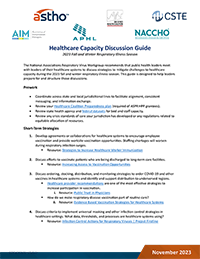Health Care Capacity Discussion Guide
2023 Fall and Winter Respiratory Illness Season
 The National Associations Respiratory Virus Workgroup recommends that public health leaders meet with leaders of their health care systems to discuss strategies to mitigate challenges to health care capacity during the 2023 fall and winter respiratory illness season. This guide is designed to help leaders prepare for and structure those discussions.
The National Associations Respiratory Virus Workgroup recommends that public health leaders meet with leaders of their health care systems to discuss strategies to mitigate challenges to health care capacity during the 2023 fall and winter respiratory illness season. This guide is designed to help leaders prepare for and structure those discussions.
Prework
- Coordinate across state and local jurisdictional lines to facilitate alignment, consistent messaging, and information exchange.
- Review your Health Care Coalition Preparedness plan (required of ASPR HPP grantees).
- Review state health agency and federal datasets for bed and staff capacity.
- Review any crisis standards of care your jurisdiction has developed or any regulations related to equitable allocation of resources.
Short-Term Strategies
-
Develop agreements or collaborations for health care systems to encourage employee vaccination and provide worksite vaccination opportunities. Staffing shortages will worsen during respiratory infection surges.
Resource: Strategies to Increase Health Care Worker Immunization (PDF)
-
Discuss efforts to vaccinate patients who are being discharged to long-term care facilities.
Resource: Increasing Access to Vaccination Opportunities (PDF)
-
Discuss ordering, stocking, distribution, and monitoring strategies to order COVID-19 and other vaccines in health care systems and identify and support distribution to underserved regions.
-
Health care provider recommendations are one of the most effective strategies to increase participation in vaccination.
Resource: Public Trust in Physicians
-
How do we make respiratory disease vaccination part of routine care?
Resource: Evidence Based Vaccination Strategies for health care Systems
-
-
Discuss criteria to implement universal masking and other infection control strategies in health care settings. What data, thresholds, and processes are health care systems using?
Resource: Infection Control Actions for Respiratory Viruses | Project Firstline
-
Discuss strategies to assess bed capacity, load leveling, and transfer management systems.
- Cover approaches to redirect or transfer patients within or across regional health care systems to prevent, postpone, or mitigate capacity issues.
-
In preparation for periods of high inpatient or acute service utilization, what is your process for load leveling patient burden across regional hospitals? What are your criteria for activating a Medical Operations Coordination Cell (MOCC)?
Resource: Medical Operations Coordination Cell Toolkit- ASPR TRACIE (PDF)
Long-Term Strategies
-
Review any agreements that you have with your health care systems on providing data on bed and staffing capacity. Identify potential areas to share additional data. Is the data impactful or helpful?
Resource: Health Care Coalition Surge Estimator Tool: Hospital Data Collection Form (automatic Excel document download)
-
Review any crisis standards of care that have been developed collaboratively or within health care systems. Identify next steps to support or develop strategies that are equitable and widely accepted.
Resource: Scarce Medical Resources Caused by COVID-19 Lead to Difficult Allocation Decisions
The National Associations Respiratory Virus Workgroup was established in August 2023 to prepare for the fall and winter respiratory virus season. The workgroup identifies gaps, priorities, and recommendations, and is comprised of state and local public health officials and senior leadership from six national public health organizations.





